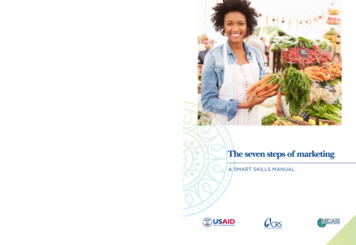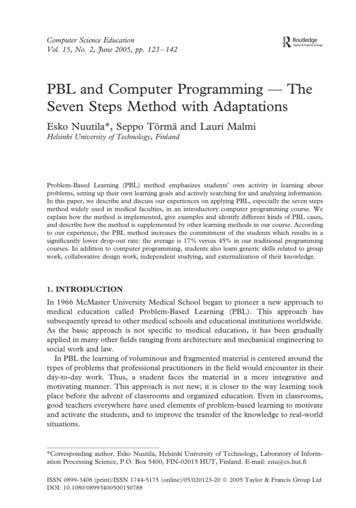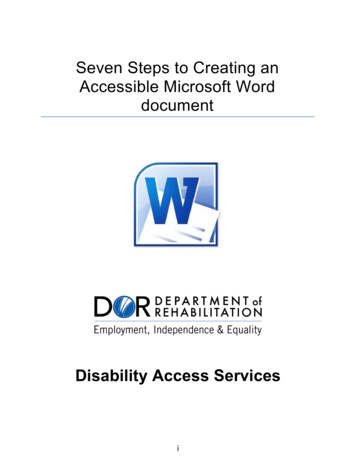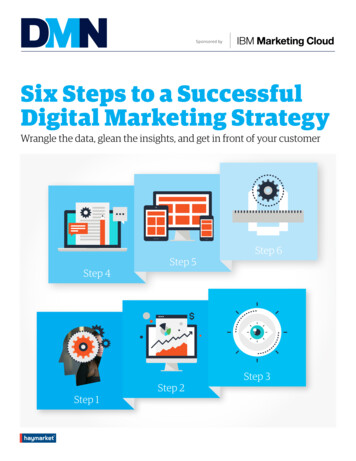
Transcription
A SMART SKILLS MANUALMarketing is one of the biggest challenges for small-scalefarmers in developing countries. Many farmers would like toimprove their output or the quality of their products, but theyneed a way to sell their produce and increase profits.The seven steps of marketingThe seven steps of marketingThis manual outlines seven steps that field agents, extensionworkers and program managers can follow to help farmersimprove their marketing:1.2.3.4.5.6.7.Getting organizedIdentifying products and organizing groupsCollecting information for the business planBuilding a business planMarketing as a groupReviewing agro-enterprise performanceScaling up.The manual consists of 21 lessons, each with guidelines,exercises to do with a group of farmers or with developmentagents, and quizzes to test your rt-skills-for-farmers/Catholic Relief Services 228 W. Lexington Street, Baltimore, MD 21201, USAFor more information, contact pqpublications@crs.org.A SMART SKILLS MANUALA SMART SKILLS MANUALThis is one manual in a series on SMART Skills – the skills thatfield agents need to help farmers in developing countriesimprove their livelihoods. A companion manual on marketingbasics describes the ideas that underlie the seven steps in thismanual.The seven steps of marketing
Seven steps of marketingA SMART SKILLS MANUALi
This publication was made possible by the generous support of the American peoplethrough the United States Agency of International Development (USAID) Office ofAcquisition and Assistance under the terms of Leader with Associates CooperativeAgreement No. AID-OAA-L-10-00003 with the University of Illinois at UrbanaChampaign for the Modernizing Extension and Advisory Services (MEAS) Project.MEAS aims at promoting and assisting in the modernization of rural extension andadvisory services worldwide through various outputs and services. The servicesbenefit a wide audience of users, including developing country policymakers andtechnical specialists, development practitioners from NGOs, other donors, andconsultants, and USAID staff and projects.Catholic Relief Services (CRS) serves the poor and disadvantaged overseas.Without regard to race, creed or nationality, CRS provides emergency relief in thewake of natural and man-made disasters and promotes the subsequent recoveryof communities through integrated development interventions. CRS’ programsand resources respond to the U.S. Bishops’ call to live in solidarity—as one humanfamily—across borders, over oceans, and through differences in language, culture andeconomic condition. CRS provided co-financing for this publication.Catholic Relief Services228 West Lexington StreetBaltimore, MD 21201-3413 USAEditorial teamShaun FerrisRupert BestPaul MundyLayout and designPaul MundyIllustrationsJorge Enrique GutiérrezISBN-10: 1 614921458ISBN-13: 978-1-61492-145-5Download this publication and related material at www.crsprogramquality.org/smartskills-for-farmers/ or at ed citation: CRS and MEAS. 2016. Seven steps of marketing: A SMART Skillsmanual. Catholic Relief Services, Baltimore, MD, and Modernizing Extension andAdvisory Services project, University of Illinois at Urbana-Champaign. 2015 Catholic Relief Services and MEAS project.This work is licensed under a Creative Commons Attribution 3.0 Unported License.Users are free: to Share — to copy, distribute and transmit the work to Remix — to adapt the workunder the condition that they attribute the author(s)/institution (but not in any waythat suggests that the authors/ institution endorse the user or the user’s use of thework).iiSEVEN STEPS OF MARKETING
Table of contentsList of tables. viCo-creators and supporters.xForeword. xiiAcknowledgments.xviiIntroduction.xviiiSTEP 1. GETTING ORGANIZED .1Lesson 1. Organizing the project team and working with the communityand project partners for the first time. 3Quiz 1. 13Staff exercise A. Assessing the marketing skills of project staff.14Exercise 1. Explaining the agroenterprise process. 17Lesson 2. Working with the community.19Quiz 2.23Exercise 2. Visioning “basic sessions”.24Lesson 3. Asset transfers and sustainability. 27Quiz 3. 30Lesson 4. Deciding where to start the project.31Quiz 4.34Staff exercise B. Choosing an entry point.35STEP 2. IDENTIFYING PRODUCTS AND ORGANIZING GROUPS .39Lesson 5. Choosing products and markets.41Quiz 5.47Exercise 5a. Choosing food products and market products .48Exercise 5b. Let’s think about new products. 50Exercise 5c. Assessing risks of product and marketing options. 52Lesson 6. Working with farmers’ groups.55Quiz 6. 64STEP 3. COLLECTING INFORMATION FOR THE BUSINESS PLAN .65Lesson 7. Market analysis.67Quiz 7. 72Exercise 7a. Market mapping. 73Exercise 7b. Market survey. 75Exercise 7c. Analyzing market information.79Lesson 8. Analyzing production.81Quiz 8.84Exercise 8. Choosing a production technology package.85Lesson 9. Surveying and fostering business services. 87Quiz 9.92iii
Exercise 9. Identifying and prioritizing service needs.93Lesson 10. Tools for financial analysis .97Quiz 10.109Exercise 10a. Calculating costs of production and marketing.110Exercise 10b. Calculating income and profit. 114Lesson 11. Deciding on credit. 115Quiz 11. 124Exercise 11. Calculating the cost of a loan. 125Lesson 12. Choosing an agroenterprise.127Quiz 12. 130Exercise 12. Choosing a product and market. 131STEP 4. BUILDING A BUSINESS PLAN. 133Lesson 13. Tools for business planning. 135Quiz 13.140Exercise 13a. Visioning . 141Exercise 13b. Market mapping.144Exercise 13c. Problem analysis. 147Exercise 13d. Preparing production targets. 148Exercise 13e. Pathway analysis .150Lesson 14. The business model canvas. 153Quiz 14. 161Exercise 14. Using the canvas to build a business plan. 163Lesson 15. Filling in the business plan. 167Quiz 15. 182Exercise 15. Filling in the business plan. 183Lesson 16. Putting the business plan into effect . 185Quiz 16. 193Exercise 16. Preparing an implementation plan.194STEP 5. MARKETING AS A GROUP. 197Lesson 17. Why market as a group?. 199Quiz 17. 214Exercise 17a. Working out transportation costs . 215Exercise 17b. A trader’s time is the farmers’ money .217Exercise 17c. Let’s talk about side-selling. 219Lesson 18. How do traders decide on prices?. 221Quiz 18.227Exercise 18. Farmer and trader pricing . 228STEP 6. REVIEWING AGROENTERPRISE PERFORMANCE. 231Lesson 19. Calculating costs, income, and profits. 233Quiz 19. 246Exercise 19. Calculating costs, income and profits .247Lesson 20. Review, documentation, and planning the next season. 255Quiz 20. 259iv SEVEN STEPS OF MARKETING
STEP 7. SCALING UP. 261Lesson 21. Scaling up. 263Quiz 21. 270Exercise 21. Your scaling up plan. 271ANNEXES.273Annex 1. Mshika Farmers’ Group .275Annex 2. Implementation plan for an agroenterprise. 297Annex 3. Conversion tables . 299Annex 4. Input costing sheet (one per crop). 301ANSWERS TO QUIZZES. 303REFERENCES AND FURTHER READING. 311Reference materials. 311Webpages and resource institutions . 311v
List of tables1. Activities in the seven steps of agroenterprise development. 42. Differences between production- and market-based strategies. 83. Possible start-up meetings and field work with communities. 94. Agroenterprise skills assessment form.155. Example of agroenterprise skills assessments for two teammembers.166. Agroenterprise team capacity form.167. Participatory tools for introducing marketing.208. Agroenterprise development entry point form. 379. Participatory tools to evaluate farmer types and product options.4210. Marketing strategies: The product/market matrix.4511. Form to list farmers’ top five food products.4912. Form to list farmers’ top five marketed products (cash crops).4913. Comparing men’s and women’s marketed (cash crop) priorities.4914. Form for minor and new crop and livestock products.5115. Checklist of requirements for marketing group. 6016. Farmers’ group sign-up sheet .6117. Key issues to address at meetings with farmers’ groups.6218. Results of a survey conducted by farmers in Soroti market,Uganda.7019. Example of a questionnaire for a market survey. 7720. Form for summarizing findings of market survey . 8021. Possible ways to increase productivity and sales prices of cropsand livestock.8322. Form for recording the requirements of a crop product.8623. Business services needed for production and marketing. 9424. Example of estimating the costs of consumable materials. 10125. Example of estimating costs of durable items. 10226. Total material costs. 10227. Example of estimating costs of labor. 10328. Total costs. 10329. Estimating income (one-time sale).10430. Estimating income (multiple sales).10431. Estimating profit.10532. Estimating profit excluding family labor.10533. Estimating profit with household consumption.10634. Form for estimating and recording costs of consumable materials. 11135. Form for estimating and recording costs of durable items. 11236. Form for estimating and recording labor costs. 11337. Calculating expected income and profit from various products. 11438. Example of a credit arrangement. 116vi SEVEN STEPS OF MARKETING
39. Estimating the amount of money a farmer needs.
The seven steps of marketing A SMART SKILLS MANUAL Marketing is one of the biggest challenges for small-scale farmers in developing countries. Many farmers would like to improve their output or the quality of their products, but they need a way to sell their produce and increase profits. This manual outlines











